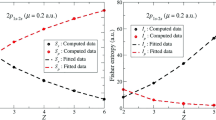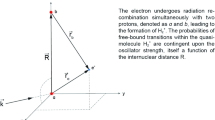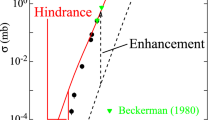Abstract
A number of processes in which highly excited states of atoms and molecules participate are investigated. These processes are of interest for the kinetics of a low-temperature plasma, for atomic and molecular spectroscopy, and for astrophysics. A quasiclassical theory is developed for transitions between Rydberg states with change of the principal quantum number, and also for the processes of direct and associative ionization of highly excited atoms, which result from collisions between a neutral particle and its atomic core. The state of the inner electrons of a quasimolecular (molecular) ion is not altered by transitions of the outer electrons. Specific calculations are carried out for the case of the collision of hydrogen H(n) with helium He (1s2) atoms. It is shown that the cross sections and the rate constants of these processes are determined in this case by the mechanism investigated in the paper, and not by scattering of the Rydberg electron by the neutral particle. The cross sections for dipole excitation and dissociation of molecular ions from high vibrational energy levels by electron impact is calculated in the Born-Coulomb approximation. The cross sections and the rates of dissociative and three-particle attachment of electrons to ions are determined. The processes of autoionization and autodissociation decay of Rydberg states of vibrationally excited molecules are determined. Also investigated are radiative transitions near the dissociation limit of diatomic molecular ions and neutral molecules, viz., photodissociation and radiative decay of high vibrational levels, and photodissociation and translational (inverse-bremsstrahlung) absorption in collision of atomic particles.
Similar content being viewed by others
Literature Cited
T. Carrington and D. Garvin, “Formation of excited particles in chemical kinetics,” in: Excited Particles in Chemical Kinetics [Russian translation], Mir, Moscow (1973), p. 164.
B. M. Smirnov and G. V. Shlaypnikov, “Radiative transitions in a molecular gas,” in: Plasma Chemistry [in Russian], No. 3, Atomizdat, Moscow (1976), pp. 130–188.
V. S. Letokhov and A. A. Makarov, “Polyatomic molecules in a strong infrared field,” Usp. Fiz. Nauk,134, No. 1, 45–91 (1981).
J. D. Poll and J. van Kranendonk, “Theory of translational absorption in gases,” Can. J. Phys.,39, 189–204 (1961).
O. Tanimoto, “Band shape of the collision-induced infrated absorption by rare gas mixtures,” Progr. Theor. Phys.,33, No. 4, 585–599 (1965).
G. V. Shlaypnikov and I. P. Shamtov, “Translational radiative transitions in collisions of atoms,” Zh. Eksp. Teor. Fiz.,79, No. 6, 2078–2086 (1980).
H. S. Heaps and G. Herzberg, “Intensity distribution in the rotation-vibration spectrum of the OH molecule,” Z. Phys.,133, No. 1, 48–64 (1952).
S. S. Penner, Quantitative Molecular Spectroscopy and Gas Emissivities, Addison-Wesley, Reading, Mass. (1959).
J. A. Gallas, “Some matrix elements for Morse oscillators,” Phys. Rev.,A21, No. 6, 1829–1834 (1980).
G. A. Askar'yan, “Strong excitation and dissociation of molecules in an intense optical field,” Zh. Eksp. Teor. Fiz.,48, No. 2, 666–672 (1965).
V. A. Kochlap and Yu. A. Kukibnyi, “Theory of high-pressure infrared laser,” Opt. Spektrosk.,34, No. 2, 328–336 (1973).
K. K. Datta, S. Saha, and A. K. Barua, “Photodissociation of HD+ by electronic and vibrational excitation,” Ind. J. Phys.,51A, No. 3, 215–219 (1977).
S. Saha, K. K. Datta, and A. K. Barua, “Photodissociation of HeH+ by both electronic and vibrational transitions,” J. Phys.,B11, No. 19, 3349–3356 (1978).
M. I. Sobel'man, Introduction to the Theory of Atomic Spectra, Pergamon, Oxford, (1973).
L. D. Landau, Collected Works [in Russian], Vol. 1, Nauka, Moscow (1969), pp. 149–155, 187–191.
E. E. Nikitin, “Calculation of the probability of vibrational excitation of molecules by collisions,” Opt. Spektrosk.,6, No. 2, 141–145 (1959).
L. D. Landau and E. M. Lifshitz, Mechanics, Pergamon Press.
M. M. Madsen and J. M. Peak, “Eigenparameters for the lowest twenty electronic states of the hydrogen molecule ion,” Atom. Data,2, No. 3, 171–204 (1971).
H. H. Michels, “Molecular orbital studies of the ground and low-lying excited states of HeH+ molecular ion,” J. Chem. Phys.,44, No. 10, 3834–3870 (1966).
T. A. Green, H. H. Michels, J. C. Browne, and M. M. Madsen, “Configuration interaction studies of the HeH+ molecular ion. I. Singlet sigma states,”ibid.,61, No. 12, 5186–5197 (1974).
P. D. Dacre, C. J. Watts, C. R. Williams, Jr., and R. McWeeny, “Molecular MCSCF calculations by direct minimization. I. The single excitation MCSCF method,” Mol. Phys.,30, No. 4, 1203–1211 (1975).
V. S. Lebedev and V. S. Marchenko, “Radiative transitions near the dissociation limit of diatomic molecules and molecular ions,” Khim. Fiz., No.12, 1589–1602 (1982).
L. P. Pitaevskii, “Recombination of electrons in a monoatomic gas,” Zh. Eksp. Teor. Fiz.,42, No. 5, 1326–1329 (1962).
D. R. Bates and S. P. Khare, “Recombination of positive ions and electrons in dense neutral gas,” Proc. Phys. Soc.,85, Pt. 2, No. 544, 231–243 (1965).
M. R. Flannery, “Semiquantal theory of heavy-particle excitation, deexcitation, and ionization by neutral atoms,” Ann. Phys. (N.Y.),61, No. 2, 465–487 (1970).
B. M. Smirnov, Ions and Excited Atoms in a Plasma [in Russian], Atomizdat, Moscow (1974), pp. 422–424.
M. Matsuzawa, “Ionization of long-lived highly excited atoms by collisions with molecules,” J. Chem. Phys.,55, No. 6, 2685–2689 (1971).
M. Matsuzawa, “State changing collision of a high Rydberg atom with polar molecules,” Phys. Rev.,A20, 861–866 (1979).
B. M. Smirnov, “Highly excited states of atoms,” Usp. Fiz. Nauk,131, No. 4, 577–616 (1980).
V. A. Smirnov and A. A. Mikhailov, “Inelastic collisions of highly excited atoms,” Opt. Spektrosk.,30, No. 5, 964–986 (1971).
A. Z. Ddvdariani, A. N. Klyucharev, A. V. Lazarenko, and V. A. Sheverov, “Collisional ionization of Rydberg states of alkali atoms,” Pis'ma Zh. Tekh. Fiz.,4, No. 17, 1013–1016 (1978).
R. K. Janev and A. A. Mihajlov, “Excitation and deexcitation process in slow collisions of Rydberg atoms with ground state parent atoms,” Phys. Rev.,A20, 1890–1897 (1979).
R. K. Janev and A. A. Mihajlov, “Resonant ionization in slow-atom-Rydberg atom collisions,” Phys. Rev.,A21, No. 3, 819–826 (1980).
A. A. Mihajlov and R. K. Janev, “Ionization in atom-Rydberg atom collisions,” J. Phys.,B14, No. 10, 1639–1654 (1981).
E. L. Duman and I. P. Shmatov, “Ionization of highly excited atoms in their parent gas,” Zh. Eksp. Teor. Fiz.,78, No. 6, 2116–2125 (1980).
B. M. Smirnov, Asymptotic Methods in the theory of Atomic Collisions [in Russian], Atomizdat, Moscow (1973).
V. P. Zhdanov and M. I. Chibisov, “Penning ionization by nonmetastable atoms,” Zh. Eksp. Teor. Fiz.,70, No. 6, 2087–2097 (1976).
Yu. P. Korchevoi, “Effectiveness of associative ionization in cesium vapor as a function of the quantum states and thermal energy of the interacting atoms,”ibid.,75, No. 4, 1231–1242 (1978).
A. N. Klucharev, A. V. Lazarenko, and V. Vujnovic, “The ionization rate coefficient of radiatively excited rubidium atoms Rb(n2P)+Rb(52S),” J. Phys.,B 13 1143–1149 (1980).
K. Radler and J. Berkowitz, “Photoionization of argon at high resolution: Collisional processes leading to formation of Ar2+ and Ar,” J. Chem. Phys.,70, No. 1, 211–227 (1979).
V. S. Lebedev, V. S. Marchenko, and S. I. Yakovlenko, “Excitation and ionization of Rydberg states of an atom in a collision of a neutral particle with a core,” Izv. Akad. Nauk SSSR, Ser. Fiz.,45, No. 12, 2395–2400 (1981).
V. S. Lebedev and V. S. Marchenko, “Transitions between highly excited states of an atom when a neutral particle passes near its atomic core,” Zh. Eksp. Teor. Fiz.,84, 1623–1634 (1983).
V. S. Lebedev and V. S. Marchenko, “Direct and associative ionization of highly excited atom when a neutral particle passes near its atomic core,” Khim. Fiz.,3, no. 2, 210–223 (1984).
V. S. Smirnov, “Inelastic collisions of highly excited atoms with inert-gas atoms,” Opt. Spektrosk.,37, No. 3, 407–410 (1974).
A. P. Hickman, “The effect of core interactions in ℓ-mixing collisions of Rydberg atoms with rare gases,” J. Phys.,B14, L419–L424 (1981).
M. Matusuzawa “Comment on ‘Thermal collisions of Rydberg atoms with neutrals’,”ibid.-14, L553–L558 (1981).
V. P. Kaulakis “Theory of collisional transitions between Rydberg levels,: Noninertial mechanism,” Litov. Fiz. Sb.,22, No. 1, 3–12, (1982).
J. I. Gersten, “Theory of collisional angular-momentum mixing of Rydberg atoms,” Phys. Rev.,A14, No. 4, 1354–1357 (1976).
R. E. Olson, “Theoretical excitation transfer cross sections for Rydberg Na(n2D→n2F) transitions from collisions with He, Ne, and Ar,” Phys. Rev.,A15, No. 2, 631–634 (1977).
A. Omont, “On the theory of collisions of atoms in Rydberg states with neutral particles,” J. Phys. (France),38, 1343–1359 (1959).
J. Derouard and M. Lombardi, “Theoretical cross sections for collisional angular momentum transfer in atomic Rydberg states,” J. Phys.,B11, No. 22, 3875–3886 (1978).
A. P. Hickman, “Theory of angular momentum mixing in Rydberg atom-rare-gas collisions,” Phys. Rev.,A18, No. 4, 1339–1342 (1978).
M. Matsuzawa, “Thermal collisions between high-Rydberg atoms and rare-gas atoms,” J. Phys.,B12, No. 22, 3743–3761 (1979).
E. de Prunelé and J. Pascale, “Theoretical model for collision of high Rydberg atoms with neutral atoms and molecules,” ibid.B12, 2511–2528.
Y. Hahn, “Thermal collisions of high Rydberg atoms with neutral particles. I: General theory and modified impulse approximation,”ibid.14, 985–996 (1981).
B. P. Kaulakis, “Theory of collisional transitions between atomic Rydberg levels: Adiabatic mechanism,” Litov. Fiz. Sb.,22, No. 5, (1982).
T. F. Gallagher, S. A. Edelstein, and R. M. Hill, “Collisional angular-momentum mixing of Rydberg states of Na by He, Ne, and Ar,” Phys. Rev.,A15, 1945–1951 (1977).
T. F. Gallagher, R. E. Olson, W. E. Cooke, et al., “Collisional angular-momentum mixing of highly excited Na (n2D) states by Ne and CO,”ibid.16, No. 1, 441–442 (1977).
T. F. Gallagher, W. E. Cooke, and S. A. Edelstein, “Collisional angular momentum mixing of f-states of Na,”ibid.17, No. 3, 904–908 (1978).
F. Gounand, P. R. Fournier, and J. Berlande, “Collisional depopulation of Rydberg P states of rubidium at thermal energies,”ibid.15, No. 6, 2212–2220 (1977).
M. Hugon, F. Gounand, P. R. Fournier, and J. Berlande, “Collisional properties of highly excited rubidium atoms,” J. Phys.,B12, No. 16, 2707–2722 (1979).
L. D. Landau and E. M. Lifshitz, Quantum Mechanics, Nonrelativisitic Theory, Pergamon (1978).
H. A. Bethe and E. E. Salpeter, Quantum Mechanics of One-and Two-Electron Systems, Springer-Verlag, Berlin (1958).
I. L. Beigman and L. A. Bureeva, “Transitions between highly excited levels,” Izv. Akad. Nauk SSSR, Ser. Fiz.,45, No. 12, 2277–2288 (1981).
L. A. Bureeva, “Quasiclassical approximation for oscillator strengths and effective cross sections of radiative transitions,” Astron. Zh.,45, No. 6, 1215–1221 (1968).
A. B. Migdal, Approximate Methods in Quantum Theory [in Russian], Nauka, Moscow (1979), pp. 85–93.
M. Abramowitz and I. A. Stegun (eds.), Handbook of Mathematical Functions, Dover, N.Y. (1964).
J. N. Beardley and M. A. Biondi, “Dissociative recombination,” Adv. Atom Mol. Phys.,6, 1–57 (1970).
A. V. Eletskii and B. M. Smirnov, “Dissociative recombination of electtron and molecular ion” Usp. Fiz. Nauk,136, No. 1, 25–59 (1982).
V. A. Ivanov and V. S. Sukhomlinov, “Properties of population of Ne levels of 2p54p configuration in dissociative recombination of Ne2 + molecular ions,” Zh. Tekh. Fiz.,52, No. 7, 1313–1317 (1982).
E. V. Ivash, “Dissociation of the hydrogen molecule ion by electron impact,” Phys. Rev.,112, 155–158 (1958).
R. F. Boikova and V. D. Ob"edkov, “Rotational and vibrational excitations of molecular ions by electrons,” Zh. Eksp. Teor. Fiz.,54, No. 5, 1439–1444 (1968).
Yu. D. Oksyuk, “Influence of vibrational excitation of molecular ions by electrons,” Opt. Spektrosk.,23, No. 3, 366–373 (1967).
J. M. Peek, “Theory of electron-H2 + dissociation collisions,” Zh. Eksp. Teor. Fiz.,A10, 539–549 (1974).
S. Saha, K. Mullick, and A. K. Barua “Effect of dipole moment on the collision induced dissociation of HD+ ion by electron impact,” J. Phys.,B5, 1369–1380 (1972).
D. R. Bates, “Dissociative recombination,” Phys. Rev.,78, No. 4, 492–493 (1950).
M. I. Chibisov and S. I. Yakovlenko, “Vibrational autoionization of molecule and recombination of nonsymmetric molecular ions,” Zh. Eksp. Teor. Fiz.,72, No. 1, 43–53 (1977).
K. R. Dastidar, M. Bose, and T. K. R. Dastidar, “Electron cooling through resonant collisions with H2 + molcular ion,” J. Phys. Soc. Jpn.,47, No. 6, 1955–1958 (1979).
V. P. Zhdanov and M. I. Chibisov, “Dissociative recombination of electrons in molecular ions H2 + and D2 + with formation of strongly excited atoms,” Zh. Eksp. Teor. Fiz.,74, No. 1, 75–85 (1978).
K. Alder, A. Bohr, T. Huus, et al., “Study of nuclear structure by electromagnetic excitation with accelerated ions,” Rev. Mod. Phys.,28, No. 4, 432–542 (1956).
Additional information
Translated from Trudy Ordena Lenina Fizicheskogo Instituta im. P. Lebedeva AN SSSR, Vol. 145, pp. 80–130, 1984.
Rights and permissions
About this article
Cite this article
Lebedev, V.S., Marchenko, V.S. Collisional and radiative processes with participation of highly excited states of atoms and molecules. J Russ Laser Res 7, 489–534 (1986). https://doi.org/10.1007/BF01120342
Issue Date:
DOI: https://doi.org/10.1007/BF01120342




